The sight across the street from SOMArts Cultural Center’s building encapsulates the gallery’s newest show to a T: a throng of rickety tents are propped up in the parking lot under the Interstate 80 overpass, its residents situated along the curb, registering as mere blurs to the busy drivers whooshing down Brannan Street.
Resistance, a show presented by the Asian Pacific Islander Cultural Center (APICC), engages with issues of gentrification and displacement, a nearly ubiquitous conversation in increasingly expensive San Francisco.

The show is part of this year’s United States of Asian America Festival (USAAF), whose theme, Civil Dis(place)ment, was directly inspired by a recent report showing 70 percent of surveyed artists in San Francisco experienced displacement from their workplace or home, according to Melanie Elvena, APICC’s artistic director.
As the exhibition title suggests, Resistance doesn’t take the issue lying down — the show not only offers Asian Pacific Islander artists’ own insights and experiences regarding different types of displacement, but also aims to empower and inform the communities directly affected by this threat.
“I ultimately want the show to not just be inspiring but also provide information — an informed individual is better equipped to make decisions on things they have greater understanding in,” says Pamela Ybañez, the show’s curator.

Ybañez hopes to bridge the supposed divide between visual and activist arts through this show, which provides hands-on engagement with its audiences through an anti-eviction workshop and panel, as well as a collection of eviction resources listed in the back of the show’s catalog.
Art has been central in plenty of Bay Area social movements, as documented by Yerba Buena Center for the Arts’ recent show around arts and media activism, but according to Pallavi Sharma, a contributing artist to Resistance, it’s a continuous process that needs to be fostered across the board.
“If we become passive creators and audiences, we won’t be heard,” Sharma says. “When we (artists) engage and invest ourselves in our community, we can intervene into what is happening and help deal with the problem instead of just sitting on pedestals.”

Gentrification and displacement in particular are issues whose effects are felt widespread, especially by disenfranchised groups such as artists and communities of color.
Eryn Kimura, whose pieces in the show touch on her family’s resistance against oppression, has been pushed out of the city herself (she currently teaches art in Japan). She believes that having a space in which a person can both thrive and exist is an essential human right repeatedly denied to these communities by the city of San Francisco.
“They put folks into affordable housing to survive, but none of these children are provided with art or resources — they don’t have adequate space to lead the lives they wish to make their mark on the world,” Kimura says.
Taking inspiration from Paulo Freire’s Pedagogy of the Oppressed, Kimura also says that having work and living space allows a community to create a site of new knowledge where people can come together to share their ideas and take part in critical dialogue.

It’s this critical dialogue — between artist and audience, between different cultural groups under threat of displacement in the city — that Elvena hopes Resistance and the other USAAF events will inspire within the community.
“Art can transcend certain barriers,” Elvena says. “It can add to this ongoing dialogue to find a solution, and I think building solidarity and coming together is where the power is.”
Resistance is on view at SOMArts Cultural Center in San Francisco through May 26, closing with a panel talk featuring the show’s artists and other speakers. For more information, visit somarts.org.

















